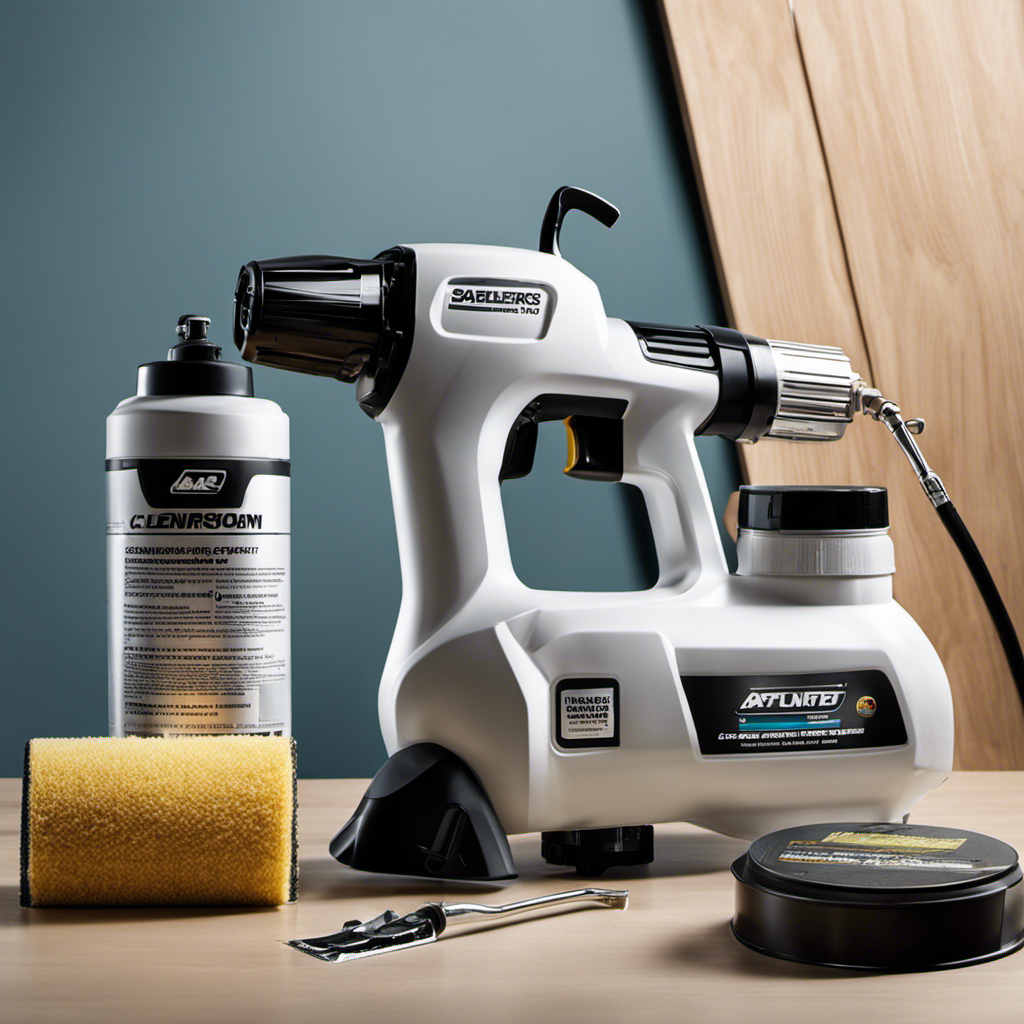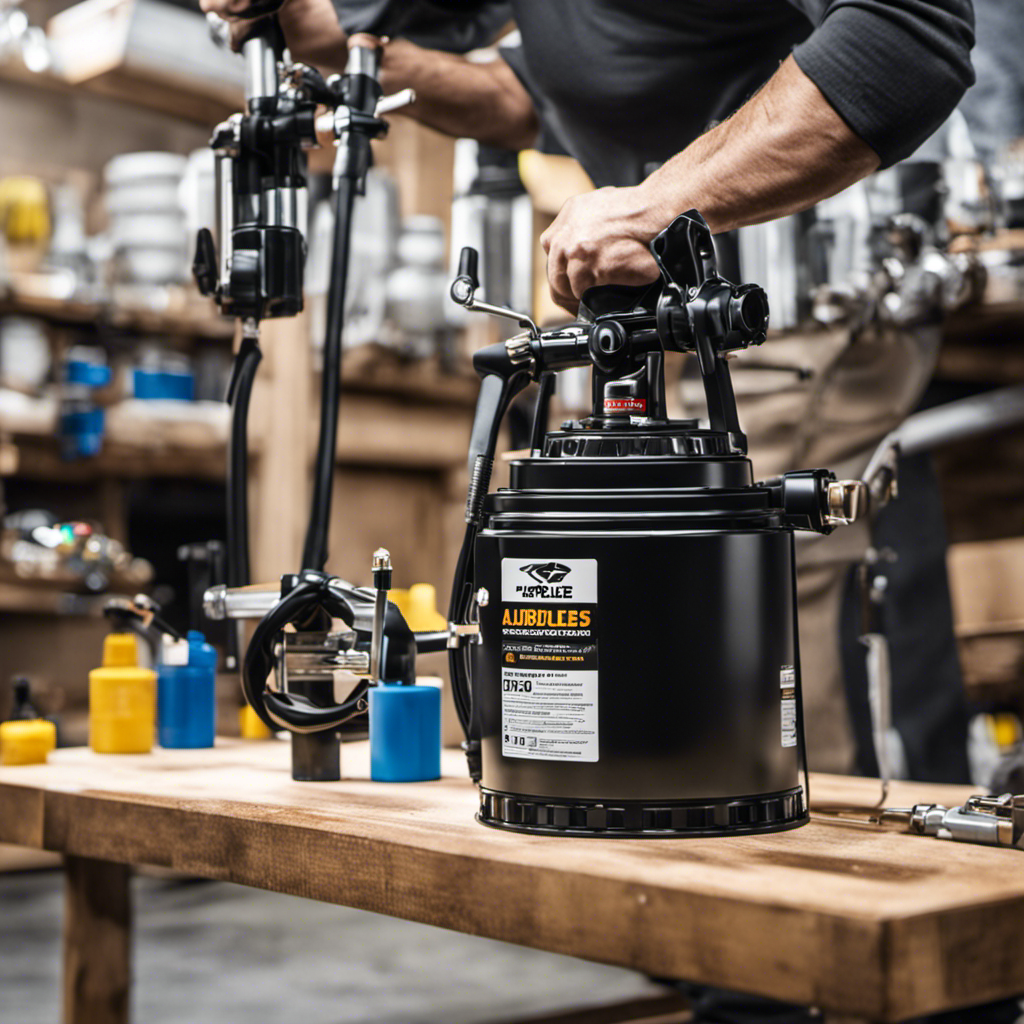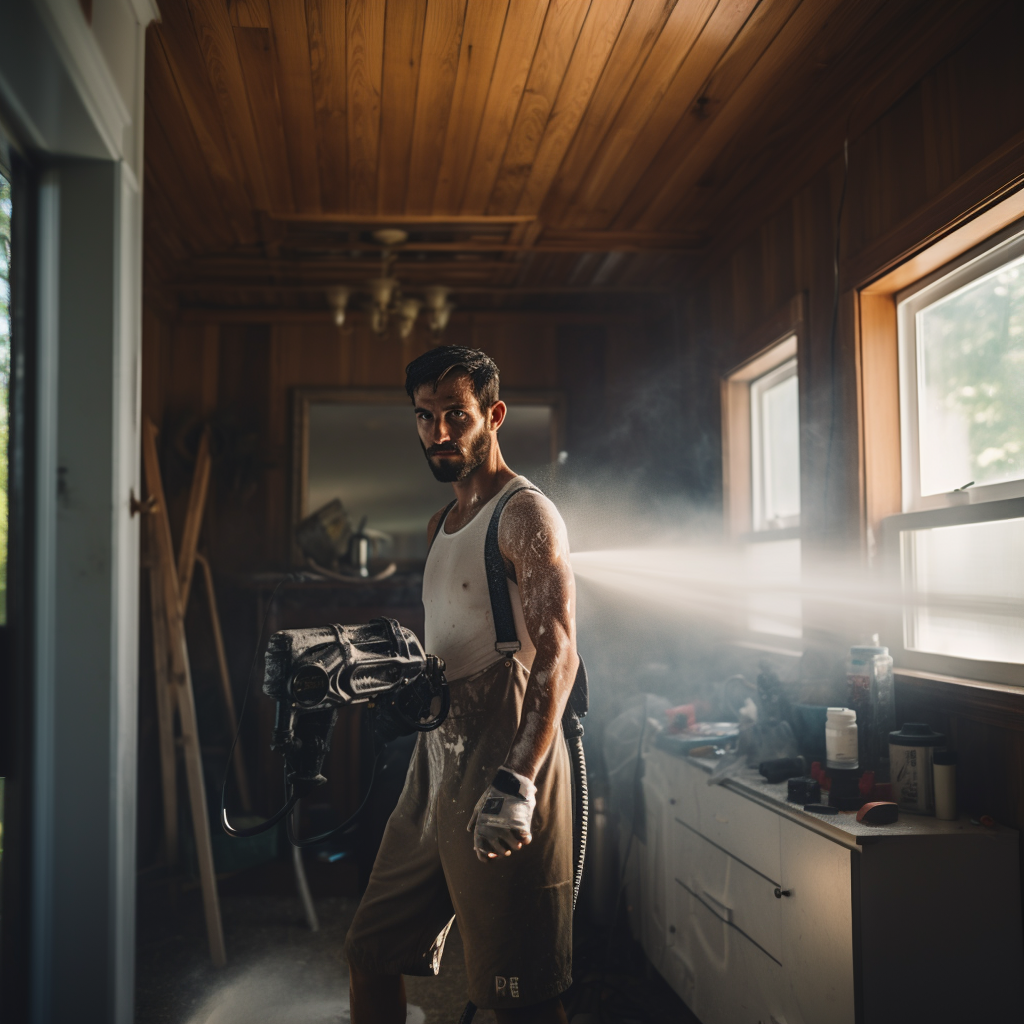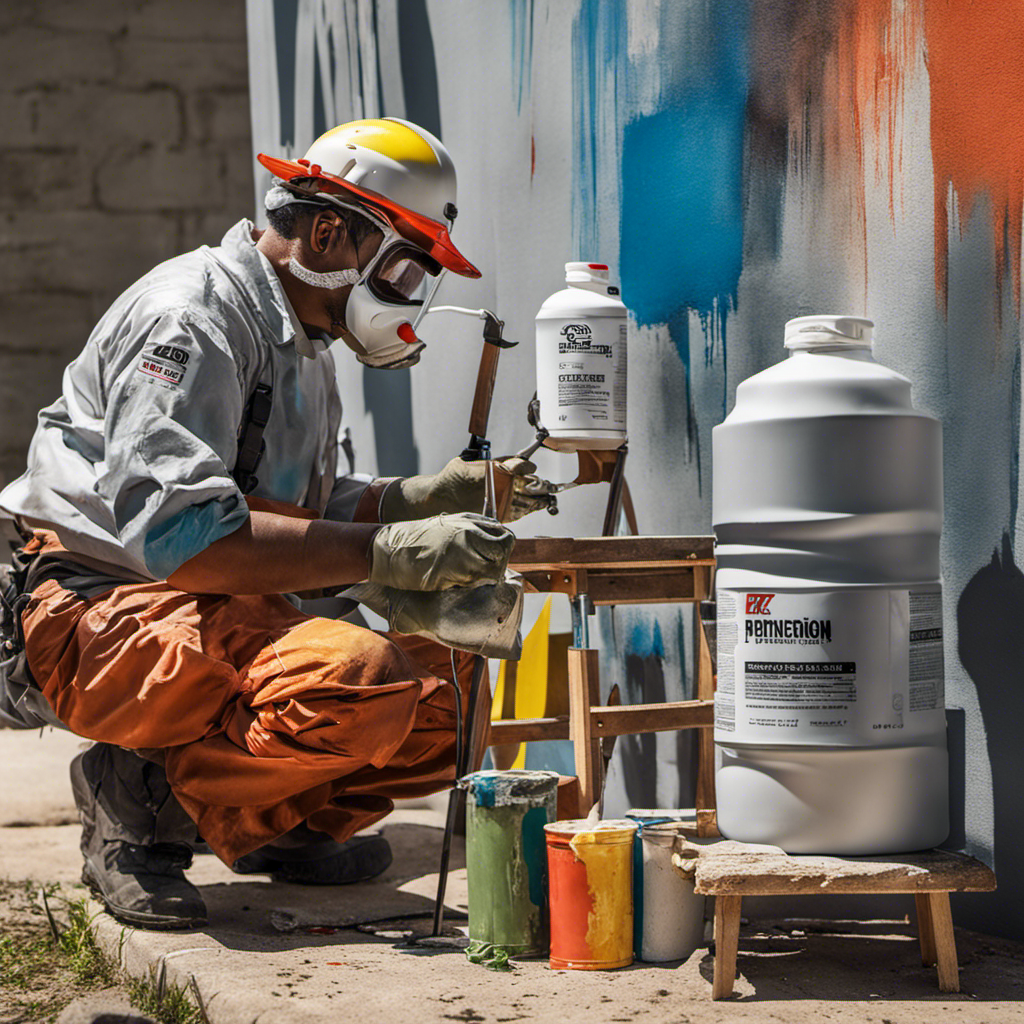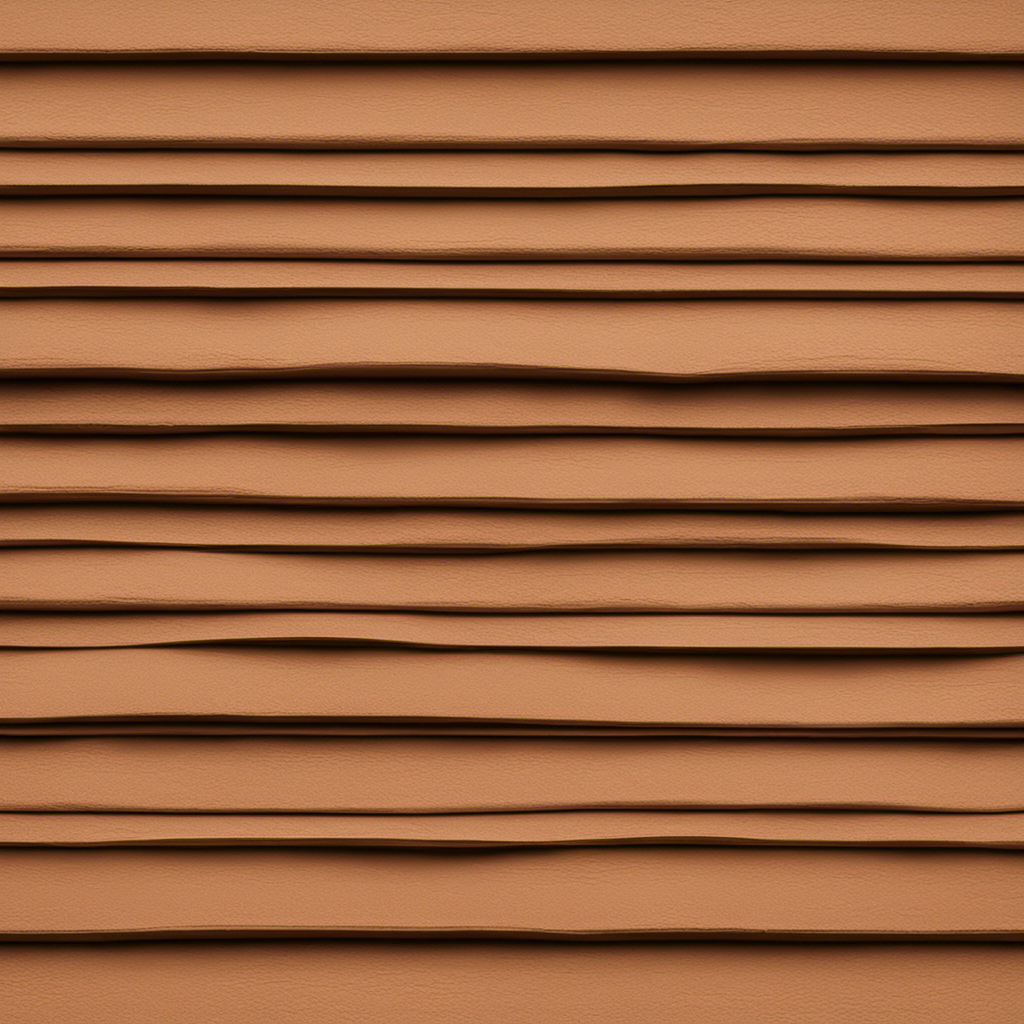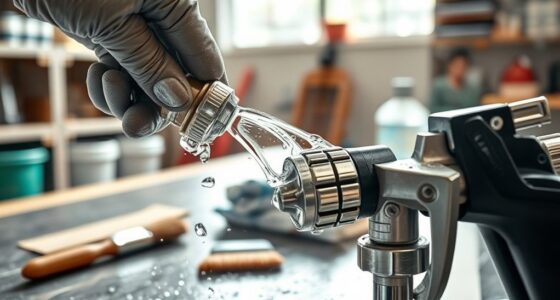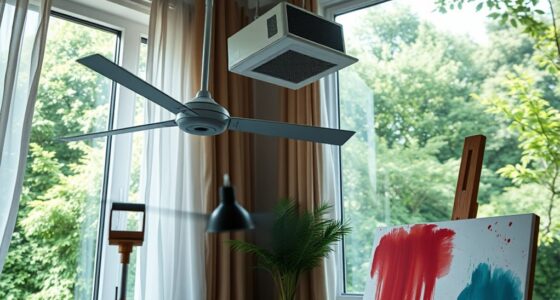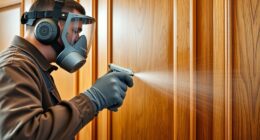Tired of struggling to clean stubborn paint residue from your airless paint sprayer? You’re in the right place! Dive right in to discover the solution to your paint removal problems.
In this article, we will guide you through the process of choosing the perfect cleaning solutions for your airless paint sprayer. By using the right cleaning solutions and following proper maintenance procedures, you can ensure the longevity and optimal performance of your sprayer.
So, grab your cleaning supplies and get ready to make your sprayer shine like new!
Key Takeaways
- Follow manufacturer guidelines for recommended cleaning solutions
- Use products specifically designed for your sprayer model
- Clean all components, including filters, hoses, nozzles, and spray tips
- Regular cleaning with appropriate solutions maintains efficiency and effectiveness
Advantages of Using an Airless Paint Sprayer
Using an airless paint sprayer saves you time with its high-pressure technology, providing a smooth and flawless finish. The advantages of using an airless paint sprayer go beyond just the time-saving aspect.
It is versatile and can be used for various painting materials. The high power output makes it ideal for larger projects. Another advantage is its efficiency in material usage, reducing waste.
However, proper maintenance and regular cleaning are crucial to ensure optimal performance. You must use compatible cleaning solutions, such as mineral spirits or paint thinner for oil-based paints, and water-based cleaners like soapy water or a water-vinegar mixture for latex or acrylic paints.
Regular cleaning after each use helps prevent clogs and build-up, prolonging the lifespan of your airless paint sprayer and ensuring it is always ready for future projects.
Types of Cleaning Solutions for Airless Paint Sprayers
To properly clean your airless paint sprayer, ensure you have the appropriate cleaning solutions for different types of paint. Here are some considerations and tips for choosing the right cleaning solution for your airless paint sprayer:
- Mineral spirits or paint thinner are suitable for oil-based paints.
- Water-based cleaners like soapy water or a water-vinegar mixture work well for latex or acrylic paints.
- Specialized solvent-based cleaners are available for stubborn coatings.
- Always follow the manufacturer’s guidelines for compatible solvents.
Proper maintenance and storage of your airless paint sprayer is essential for long-lasting performance. Here’s how to do it:
- Regularly clean all components after each use to prevent clogs and build-up.
- Use cleaning solutions specifically designed for airless paint sprayers.
- Thoroughly rinse all components with clean water.
- Properly store the sprayer in a clean and dry place.
Mineral Spirits or Paint Thinner for Oil-Based Paints
When cleaning oil-based paints from your airless paint sprayer, you’ll need to use mineral spirits or paint thinner. These solvents effectively break down the oil-based paint and help remove it from the sprayer components.
However, it is important to note that using alternative cleaning solutions may have an impact on the quality of the paint. Mineral spirits and paint thinner are specifically formulated to dissolve oil-based paints without damaging the sprayer.
They help remove any residue or build-up, ensuring that the sprayer functions properly for future use. Using other cleaning solutions may not provide the same level of effectiveness and could potentially affect the paint quality.
It is always best to follow manufacturer guidelines and use the recommended solvents for cleaning your airless paint sprayer.
Water-Based Cleaners for Latex or Acrylic Paints
For effective cleaning of latex or acrylic paints from your airless paint sprayer, water-based cleaners like soapy water or a water-vinegar mixture are highly recommended. These gentle cleaning solutions are effective in removing water-based paints and are less harsh on the sprayer components.
However, for oil-based paints, you will need to use specialized cleaners such as mineral spirits or paint thinner. These solvents are specifically designed to dissolve and remove oil-based paints from the sprayer.
Additionally, if you encounter stubborn coatings that are difficult to remove, there are specialized solvent-based cleaners available in the market. These cleaners are formulated to tackle tough and stubborn paints, ensuring a thorough cleaning of your airless paint sprayer.
Remember to always follow the manufacturer’s guidelines for compatible solvents and to clean your sprayer regularly to prevent clogs and build-up.
Specialized Solvent-Based Cleaners for Stubborn Coatings
If you encounter stubborn coatings that are difficult to remove, specialized solvent-based cleaners can effectively dissolve and remove them from your airless paint sprayer. These cleaners are specifically designed to tackle tough and stubborn coatings that may not be effectively removed by water-based cleaners.
Specialized solvent-based cleaners contain powerful solvents that can break down and dissolve even the most stubborn coatings, such as oil-based paints or heavy-duty industrial coatings. To remove these stubborn coatings, simply apply the solvent-based cleaner to the affected areas and allow it to work its magic. After a few minutes, you can use a brush or cloth to scrub away the dissolved coating.
Make sure to follow the manufacturer’s instructions and safety precautions when using these cleaners, and always wear protective gloves and eyewear. By using specialized solvent-based cleaners, you can easily remove stubborn coatings from your airless paint sprayer and maintain its optimal performance.
Manufacturer Guidelines for Compatible Solvents
To ensure optimal performance of your airless paint sprayer, always consult the manufacturer’s guidelines for compatible solvents. This is crucial as using the wrong solvents can damage the sprayer and affect the quality of your paint job.
The manufacturer’s guidelines will provide you with specific recommendations on the types of solvents that are safe to use with your particular sprayer model. When choosing solvents, consider factors such as the type of paint you are using, whether it is oil-based or water-based, and the level of stubbornness of any coatings.
Regular Cleaning After Each Use to Prevent Clogs
After each use, make sure to clean your airless paint sprayer thoroughly to prevent clogs and maintain optimal performance. This is crucial for preventing any blockages or build-up that can hinder the sprayer’s effectiveness.
Choosing the right cleaning solution for different paint types is also important to ensure proper cleaning and prevent any damage to the equipment. Here are some tips for preventing clogs and choosing the right cleaning solution:
- Regularly clean all components, including filters, hoses, nozzles, and spray tips.
- Use compatible cleaning solutions designed for airless paint sprayers.
- Follow manufacturer guidelines for recommended cleaning solutions.
- Clean the sprayer immediately after each use to prevent any dried paint from clogging the system.
- Properly store the sprayer in a clean and dry place to avoid any contamination.
Steps to Clean an Airless Paint Sprayer
Start by relieving the pressure of your airless paint sprayer by turning it off and triggering the gun. Proper cleaning techniques are essential to maintain the efficiency and longevity of your airless paint sprayer. Here are the steps you need to follow:
- Disconnect hoses and remove filters or tips.
- Flush the system with a suitable cleaning solution.
- Rinse all components thoroughly with clean water.
- Reassemble and perform a test spray without paint to ensure proper functioning.
Common mistakes to avoid during the cleaning process include neglecting to relieve the pressure before disassembling the sprayer, using incompatible cleaning solutions, and not thoroughly rinsing all components.
Relieving Pressure and Disconnecting Hoses
Now that you’ve learned about the steps to clean an airless paint sprayer, let’s discuss the importance of proper storage for your sprayer and some tips for troubleshooting common issues.
Proper storage is crucial to maintain the performance and longevity of your airless paint sprayer. After cleaning, ensure that all components are thoroughly dried before storing them. Store the sprayer in a clean and dry place, away from extreme temperatures and direct sunlight. This will prevent damage and corrosion.
When it comes to troubleshooting common issues, start by checking the power source and ensuring that the sprayer is properly connected. If the sprayer is not priming or producing a consistent spray pattern, check for clogs or blockages in the filters, hoses, or nozzles. Clean or replace any clogged components as necessary.
If the sprayer is leaking or spraying unevenly, check for loose connections or worn seals. Tighten any loose connections and replace any damaged seals to resolve the issue.
Flushing the System With a Suitable Cleaning Solution
To flush the system with a suitable cleaning solution, you’ll need to disconnect hoses and remove filters or tips. Choosing the best cleaning solution for your airless paint sprayer is crucial to maintaining its performance and longevity. The importance of using the recommended cleaning solution cannot be overstated.
Here are a few key factors to consider when selecting a cleaning solution for your airless paint sprayer:
-
Compatibility: Follow the manufacturer’s guidelines and use products specifically designed for your sprayer model. Using incompatible cleaning solutions may damage the sprayer or lead to inefficient cleaning.
-
Thoroughness: Ensure that the cleaning solution effectively removes paint residue and prevents clogs and blockages. Regular cleaning with appropriate solutions maintains the sprayer’s efficiency and effectiveness.
-
Safety: Choose cleaning solutions that are safe to use and environmentally friendly. Avoid using harsh chemicals that may cause harm to you, the environment, or the sprayer components.
-
Ease of use: Look for cleaning solutions that are easy to apply and rinse off. This will make the cleaning process more convenient and efficient.
Thoroughly Rinsing All Components With Clean Water
Disconnect the hoses and remove the filters or tips before thoroughly rinsing all components with clean water. Properly rinsing the components of your airless paint sprayer is essential to ensure its longevity and optimal performance. After flushing the system with a suitable cleaning solution, rinsing with clean water removes any remaining residue or cleaning solution from the sprayer. This step is crucial as it prevents any leftover chemicals from affecting the quality of your paint job. Additionally, it is important to emphasize the importance of proper drying techniques after rinsing. Allowing the components to air dry or using compressed air to remove excess water helps prevent corrosion and damage. Lastly, choosing the right spray tip size is crucial for achieving the desired paint coverage and finish. The table below provides a guide for selecting the appropriate spray tip size based on the material being used and the desired application.
| Material | Spray Tip Size |
|---|---|
| Stains | 0.009-0.013 |
| Enamels | 0.013-0.017 |
| Latex | 0.015-0.021 |
| Primer | 0.017-0.023 |
| Heavy Coatings | 0.021-0.027 |
Following these guidelines ensures optimal performance and a professional finish for your airless paint sprayer.
Reassembling and Performing a Test Spray Without Paint
After rinsing all components with clean water, reassemble your airless paint sprayer and perform a test spray without paint to ensure that it’s functioning properly. This step is crucial in troubleshooting common issues and ensuring that your sprayer is ready for the next painting project.
Here are some reassembling techniques to follow:
- Carefully align and connect hoses, making sure they’re securely attached.
- Reattach filters and tips, ensuring they’re properly seated.
- Double-check all connections to prevent leaks and ensure proper functionality.
- Test the sprayer by spraying water or a cleaning solution through the nozzle to verify that it’s working correctly.
Importance of Regular Maintenance and Proper Cleaning
Regular maintenance and proper cleaning of your airless paint sprayer are essential tasks that ensure its longevity and optimal performance. By regularly cleaning your airless paint sprayer, you prevent clogs, blockages, and performance issues that can arise from dried paint or debris buildup.
The role of cleaning solutions in maintaining efficiency and effectiveness cannot be overstated. It is important to use compatible cleaning solutions specifically designed for airless paint sprayers. For oil-based paints, mineral spirits or paint thinner are recommended, while water-based cleaners like soapy water or a water-vinegar mixture work well for latex or acrylic paints. Specialized solvent-based cleaners may be necessary for stubborn coatings.
Thoroughly clean all components, including filters, hoses, nozzles, and spray tips, after each use. Proper maintenance and cleaning will not only prolong the lifespan of your airless paint sprayer but also ensure that it is ready for future projects.
Frequently Asked Questions
Can I Use Any Cleaning Solution for My Airless Paint Sprayer?
Yes, you can use any cleaning solution for your airless paint sprayer, but it’s important to choose the right one. Consider factors such as the type of paint you use and the manufacturer’s recommendations.
It’s best to use recommended cleaning products specifically designed for your sprayer model. Clean all components thoroughly, including filters, hoses, nozzles, and spray tips.
Regular cleaning with appropriate solutions will maintain the efficiency and effectiveness of your airless paint sprayer.
How Often Should I Clean My Airless Paint Sprayer?
To maintain the longevity of your airless paint sprayer and prevent clogs, it’s important to clean it regularly. After each use, thoroughly clean all components with suitable cleaning solutions. Follow the manufacturer’s guidelines for recommended cleaning frequency.
Properly store the sprayer in a clean and dry place to avoid damage. By keeping up with regular maintenance and cleaning, you can ensure the effectiveness and efficiency of your airless paint sprayer for future projects.
Are There Any Specific Cleaning Techniques I Should Follow for My Airless Paint Sprayer?
To maintain the performance of your airless paint sprayer, it’s important to follow specific cleaning techniques.
Start by relieving pressure, disconnecting hoses, and removing filters or tips.
Then, flush the system with a suitable cleaning solution and rinse all components thoroughly with clean water.
Reassemble and perform a test spray without paint to ensure proper functioning.
Using the right cleaning solution is crucial to avoid clogs and blockages.
Regular cleaning with appropriate solutions will maintain the efficiency and effectiveness of your sprayer.
What Should I Do if My Airless Paint Sprayer Gets Clogged During Use?
If your airless paint sprayer gets clogged during use, don’t panic! First, stop spraying and relieve the pressure.
Then, follow these steps to unclog it: disconnect hoses, remove filters or tips, and flush the system with a suitable cleaning solution. Rinse all components thoroughly with clean water, reassemble, and perform a test spray without paint.
To prevent clogs in the future, use cleaning solutions specifically designed for airless paint sprayers and clean all components after each use.
Can I Use Homemade Cleaning Solutions for My Airless Paint Sprayer?
Yes, you can use homemade cleaning solutions for your airless paint sprayer. However, it’s important to note that commercial cleaning solutions have several benefits.
They are specifically designed for airless paint sprayers and ensure thorough cleaning without damaging the components. Alternative cleaning methods may not be as effective and could potentially lead to clogs or blockages.
Therefore, it is recommended to use commercial cleaning solutions to maintain the efficiency and effectiveness of your airless paint sprayer.
Conclusion
In conclusion, choosing the perfect cleaning solutions for your airless paint sprayer is vital for its longevity and optimal performance. By using the right cleaning solutions and following proper maintenance procedures, you can ensure that your sprayer is always ready for future projects.
Just like a well-oiled machine, regular cleaning after each use prevents clogs and blockages, allowing for flawless and efficient painting. It’s like giving your sprayer a breath of fresh air, clearing away any residue and ensuring a pristine finish every time.
So, remember to choose the right cleaning solutions and take good care of your airless paint sprayer to enjoy its advantages and prolong its lifespan.
Franz came aboard the Paint Sprayer Zone team with a background in both journalism and home renovation. His articulate writing style, combined with a passion for DIY projects, makes him an invaluable asset. Franz has a knack for breaking down technical jargon into easy-to-understand content, ensuring that even the most novice of readers can grasp the complexities of paint sprayers.
